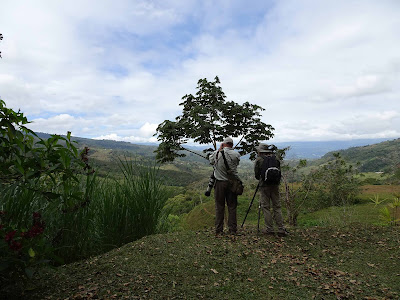We met our guide Harry before breakfast to find some early-morning birds. Rancho Naturalista occasionally runs a bright blacklight at night to attract insects, which in turn attract insect-eating birds. So we headed for the blacklight to see what we could find.
Many of the birds that come in to eat the insects are shy, cryptically colored forest birds like the various Woodcreepers.
We also got outstanding looks at this Buff-throated Foliage-Gleaner.
At breakfast Harry asked us if we had any particular "target birds" while we were there. We mentioned that we'd like to see some of the tiniest hummingbirds, including the Snowcap, Green Thorntail, and Black-crested Coquette. After breakfast we headed off with Harry on a private walk in search of those, and other species.
Many of the birds that come in to eat the insects are shy, cryptically colored forest birds like the various Woodcreepers.
Plain-brown Woodcreeper
Spotted Woodcreeper
Wedge-billed Woodcreeper
We also got outstanding looks at this Buff-throated Foliage-Gleaner.
Buff-throated Foliage-Gleaner
As you can see, not all tropical birds are brightly colored. Many of the forest dwellers are pretty well camouflaged.
At breakfast Harry asked us if we had any particular "target birds" while we were there. We mentioned that we'd like to see some of the tiniest hummingbirds, including the Snowcap, Green Thorntail, and Black-crested Coquette. After breakfast we headed off with Harry on a private walk in search of those, and other species.
Harry is from England and has been a guide at Rancho for 8 years. He was great at identifying bird and their songs. He was also very knowledgeable about the trees and flowers in the area.
Lush green forest
Great views
We started at a nearby residence where the owner has feeders and allows the Rancho folks to visit. We saw a male Green Hermit at one of the feeders. Hermits are a type of hummingbird known for their long curved bills and elongated tails.
Green Hermit
Lesson's Motmot (formerly Blue-crowned Motmot) is a well-known tropical species. Motmots are known for their distinctive "racket-tipped" tails.
Lesson's Motmot
From this first residence we birded down the entry road until we came to Racho Bajo, the home of the family that owns Rancho Naturalista. They have some amazing gardens around the home, and this was the place to find the tiny hummingbirds.
First we saw the Green Thorntail. This tiny (3") hummingbird looks like a bee as it flits around the flowers. The males distinctive long tail is unique.
First we saw the Green Thorntail. This tiny (3") hummingbird looks like a bee as it flits around the flowers. The males distinctive long tail is unique.
Green Thorntail male
Green Thorntail male
The female lacks the tail extension but is very striking.
Green Thorntail female
Next we found a Snowcap. The name is obvious once you see the bird. The bright white cap contrasts with the dark coppery-colored body and makes photography very challenging. As with many other hummingbirds, the female looks very different.
Snowcap male
The third tiny hummingbird of our search was the Black-crested Coquette. The male has a long, wiry crest and collar of black feathers, but we never saw one. We did however get good looks at the female, so we were successful in our Tiny Hummingbird Trifecta!
Black-crested Coquette female
BTW - can you tell that Blue Porterweed is the finest hummingbird plant in all of Costa Rica??
Next time: More Rancho birding.



















I still can't see the subtle details that allow you to identify a species, let alone female and male of the same species. You two are amazing in your talents.
ReplyDeleteMuch of it is subtle, but the field guides (books) for Costa Rica have gotten very good. Big help!
Delete...If you click on one of your photos while trying to compose a comment you can't get back to the comment. Aargh. I was trying to say I like the photo that shows the black in the middle of the crown of the Lesson's Motmot.
ReplyDeleteYou've got to love the peculiarities of Blogger!
Delete